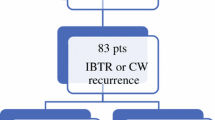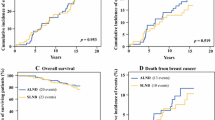Abstract
Background: Routine axillary lymph node dissection (ALND) for elderly women with invasive breast cancer has been questioned because it rarely alters therapy yet carries a significant morbidity rate. Sentinel lymphadenectomy (SLND) improves axillary staging and alters therapy in women with T1 breast cancer, but it is not clear whether SLND alters therapy in elderly women with breast cancer.
Methods: A prospective breast cancer data base was used to identify women 70 years old and older who underwent SLND for axillary staging of invasive breast cancer between 1991 and 1998.
Results: There were 75 invasive breast cancers in 73 women. The mean patient age was 74.5 years (range, 70–90 years). Median tumor size was 1.4 cm (range, 0.1– 6.2 cm). Of the 75 tumors, 42 (56%) had favorable primary characteristics; the remaining tumors had unfavorable characteristics. SLND was performed alone in 17 cases (23%) and was followed by completion ALND in 58 cases (77%). Positive lymph nodes were identified in 32 cases (43%); 26 (81.3%) were detected by hematoxylin and eosin stains, and 6 (18.7%) were detected by immunohistochemistry alone. Five patients (6.9%) received adjuvant chemotherapy. Seven patients (9.6%) received axillary/supraclavicular radiation for positive nodes. Ten (13.7%) of 73 patients had obvious alterations in therapy because of axillary nodal status. As a result of SLND, 3 (13.6%) of 22 patients with tumors 1.0 cm or smaller received tamoxifen, and 7 (15%) of 46 patients with tumors between 1.0 and 3.0 cm in size had changes in therapy. When patient and tumor characteristics were analyzed to determine relationships to therapeutic decision-making, nodal status was the variable most significantly associated with changes in therapy (P 5 .0001).
Conclusions: SLND improves axillary staging in elderly women with invasive breast cancer. Results of immunohistochemistry do not alter therapy in this group of individuals (P 5 .6367). In patients with small primary tumors, SLND alters therapy by increasing the number of patients receiving tamoxifen. In addition, SLND affects adjuvant systemic chemotherapy and regional radiotherapy in a significant number of patients with larger tumors, particularly tumors between 1.0 and 3.0 cm.
Similar content being viewed by others
References
Mansour EG, Gray R, Shatila AH, et al. 1989; Efficacy of adjuvant chemotherapy in high-risk node-negative breast cancer. N Engl J Med 320:485–9.
Fisher B, Redmond C, Wickerham L, et al. 1989; Systemic therapy in patients with node-negative breast cancer. Ann Intern Med 111:708–12.
Fisher B, Dignam J, Mamounas EP, et al. 1996; Sequential methotrexate and fluorouracil for treatment of node-negative breast cancer patients with estrogen receptor-negative tumors. J Clin Oncol 14:1982–92.
Cady B, Stone MD, Wayne J. 1993; New therapeutic possibilities in primary invasive breast cancer. Ann Surg 3:338–49.
Silverstein MJ, Gierson ED, Waisovan JR, et al. 1994; Axillary lymph node dissection for T1a breast carcinoma: is it indicated? Cancer 73:664–7.
Ivens D, Hoe AL, Podd TJ, et al. 1992; Assessment of morbidity from complete axillary dissection. Br J Cancer 66:136–8.
Lin PP, Allison DC, Wainstock J, et al. 1993; Impact of axillary lymph node dissection on the therapy of breast cancer patients. J Clin Oncol 11:1536–44.
Hladiuk M, Huchcroft S, Temple W, Schnurr BE. 1992; Arm function after axillary dissection for breast cancer: a pilot study to provide parameter estimates. J Surg Oncol 50:47–52.
Naslund E, Fernstad R, Ekman S, et al. 1996; Breast cancer in women over 75 years: is axillary dissection always necessary? Eur J Surg 162:867–71.
Dees EC, Shulman LN, Souba WW, et al. 1997; Does information from axillary dissection change treatment in clinically node-negative patients with breast cancer: an algorithm for assessment of impact of axillary dissection. Ann Surg 226:279–87.
Feigelson BJ, Acosta JA, Feigelson HS, et al. 1996; T1 breast carcinoma in women 70 years of age and older may not require axillary lymph node dissection. Am J Surg 172:487–9.
Giuliano AE, Kirgan DM, Guenther JM, Morton DL. 1994; Lymphatic mapping and sentinel lymphadenectomy for breast cancer. Ann Surg 220:391–401.
Giuliano AE, Dale PS, Turner RR. 1995; Improved axillary staging of breast cancer with sentinel lymphadenectomy. Ann Surg 222: 394–401.
Turner RR, Ollila DW, Krasne DL, Giuliano AE. 1997; Histopathologic validation of the sentinel node hypothesis for breast carcinoma. Ann Surg 226:271–8.
Ollila DW, Brennan MB, Giuliano AE. 1998; Therapeutic effect of sentinel lymphadenectomy in T1 breast cancer. Arch Surg 133:647–51.
Wazer DE, Erban JK, Robert NJ, et al. 1994; Breast conservation in elderly women for clinically negative axillary lymph nodes without axillary dissection. Cancer 74:878–83.
Von Rueden DG, Sessions SC. 1994; Alternative therapy for elderly patients with breast cancer. Am Surg 60:72–8.
Diab SG, Hilsenbeck SG, de Moor C, et al. 1998; Radiation therapy and survival in breast cancer patients with 10 or more positive axillary lymph nodes treated with mastectomy. J Clin Oncol 16: 1655–6.
Ragaz J, Jackson SM, Plenderleith IH, et al. 1993; Can adjuvant locoregional radiotherapy (XRT) reduce systemic recurrences in stage I-II breast cancer patients? 10 year analysis of the British Columbia randomized trial [Abstract]. Proc Am Soc Clin Oncol 12:6.
Vicini FA, Horwitz EM, Lacerna MD, et al. 1997; The role of regional nodal irradiation in the management of patients with early-stage breast cancer treated with breast-conserving therapy. Int J Radiat Oncol Biol Phys 39:1069–76.
Chu KU, Turner RR, Hansen NM, Brennan MB, Bilchik A, Giuliano AE. 1999; Do all patients with sentinel node metastasis from breast carcinoma need complete axillary node dissection? Ann Surg 229:536–41.
Author information
Authors and Affiliations
Corresponding author
Rights and permissions
About this article
Cite this article
DiFronzo, L.A., Hansen, N.M., Stern, S.L. et al. Does Sentinel Lymphadenectomy Improve Staging and Alter Therapy in Elderly Women With Breast Cancer?. Ann Surg Oncol 7, 406–410 (2000). https://doi.org/10.1007/s10434-000-0406-1
Received:
Accepted:
Issue Date:
DOI: https://doi.org/10.1007/s10434-000-0406-1




